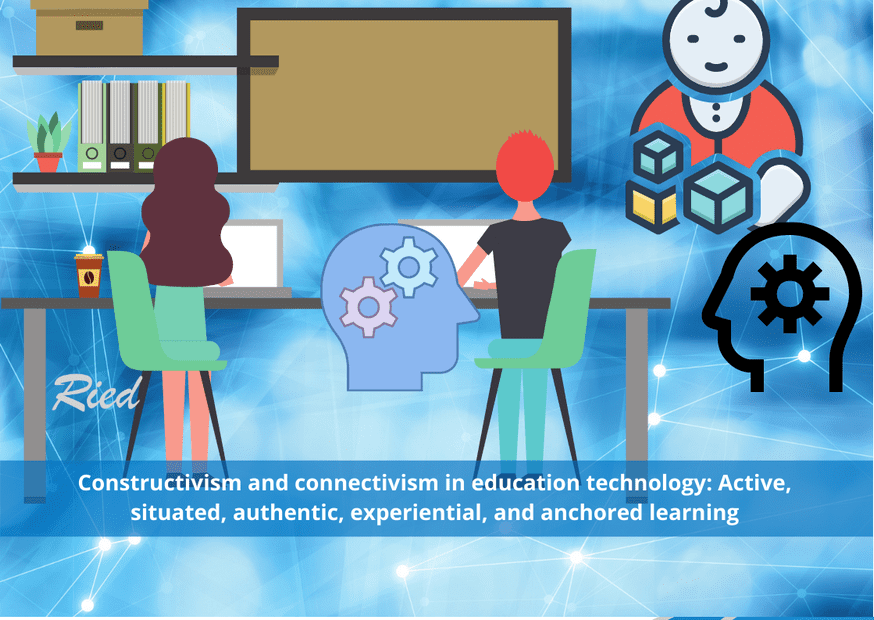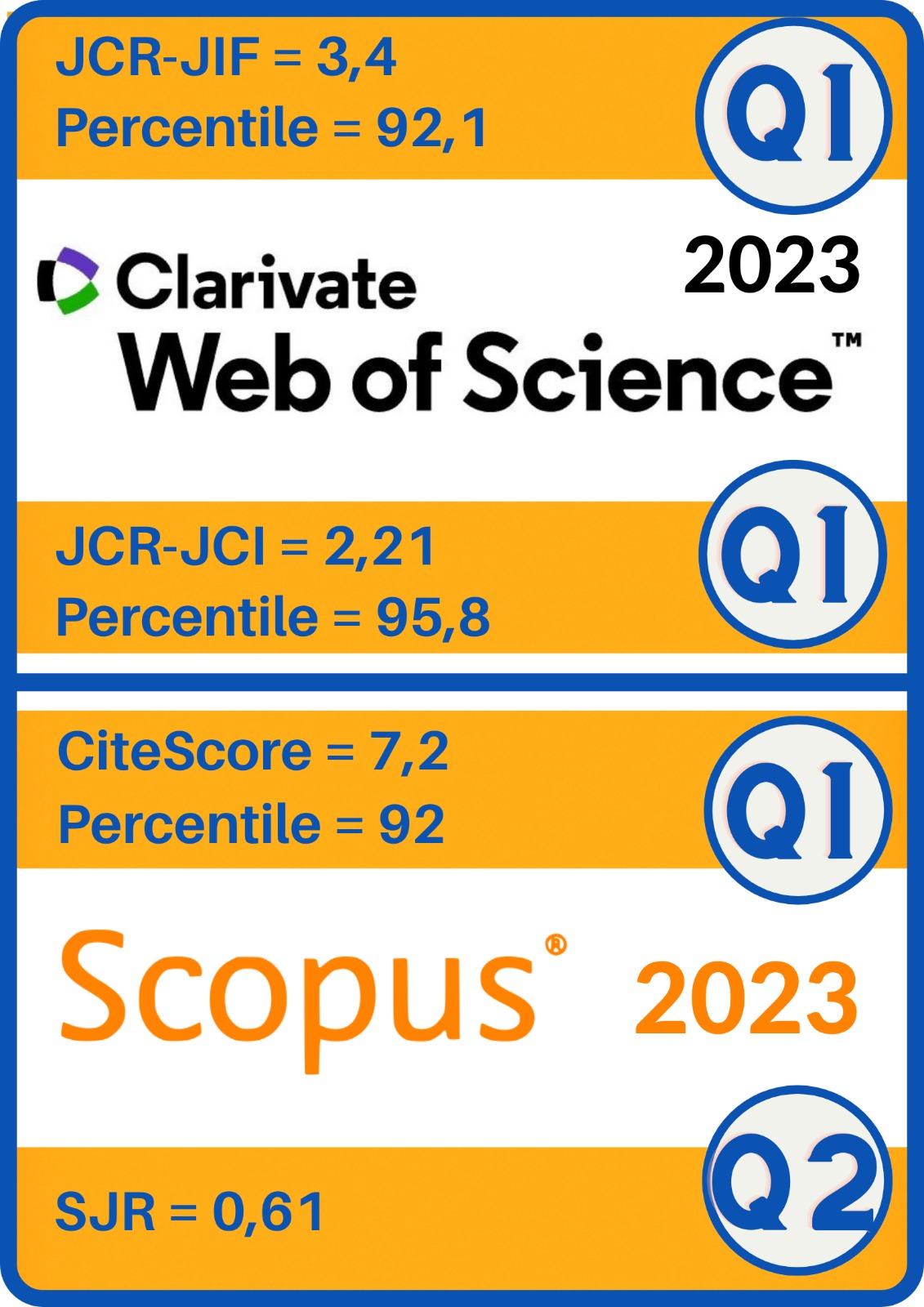El constructivismo y el conectivismo en tecnología educativa: El aprendizaje activo, situado, auténtico, experiencial y anclado
DOI:
https://doi.org/10.5944/ried.21.2.20055Palabras clave:
aprendizaje, cognición, tecnología de la educación, educación a distancia.Resumen
Este artículo teórico pretende comparar algunas teorías de aprendizaje relacionadas con el constructivismo y explorar cómo pueden usarse adecuadamente en el campo de la tecnología educativa y la educación a distancia. Después de una breve introducción, el constructivismo queda definido como una filosofía general de la educación que abarca varias teorías de aprendizaje diferentes. El artículo presenta y analiza las siguientes teorías: cognición situada, teoría de la actividad, aprendizaje experiencial, instrucción anclada y aprendizaje auténtico. El conectivismo o aprendizaje distribuido también se presenta como una nueva e importante teoría, que incluye su visión pedagógica y práctica en cursos masivos y abiertos en línea (MOOCs). Organizamos estas teorías de manera coherente bajo el paraguas constructivista e indicamos las principales similitudes y diferencias entre ellas. El conectivismo se posiciona como una nueva filosofía de la educación para la era digital, flexibilizando y ampliando el concepto de Zona de Desarrollo Próximo (ZDP) de Vygotsky para incluir el aprendizaje que se encuentra fuera del alumno, en redes sociales y herramientas tecnológicas. El texto finalmente propone un trabajo adicional sobre cómo estas teorías pueden combinarse y utilizarse adecuadamente como marcos para proyectos y actividades constructivistas en los campos de la tecnología educativa y la educación a distancia. El artículo se basa en la investigación y revisión de artículos revisados por pares sobre el constructivismo, el conectivismo, las otras teorías mencionadas y la tecnología educativa y la educación a distancia.
Descargas
Citas
Anderson, T. (2016). Theories for learning with emerging technologies. In G. Veletsianos (Ed.), Emergence and innovation in digital learning: Foundations and applications (pp. 35-64). Edmonton: Athabasca University Press.
Anderson, T., & Dron, J. (2011). Three generations of distance education pedagogy. The International Review of Research in Open and Distributed Learning, 12(3), 80-97.
Anderson, T., & Dron, J. (2012). Learning technology through three generations of technology enhanced distance education pedagogy. European Journal of Open, Distance and e-learning, 15(2).
Bardin, L. (2013). L’analyse de contenu. Paris: Presses Universitaires de France.
Beckem, J. M., & Watkins, M. (2012). Bringing life to learning: Immersive experiential learning simulations for online and blended courses. Journal of Asynchronous Learning Networks, 16(5), 61-70.
Bedwell, W. L., Pavlas, D., Heyne, K., Lazzara, E. H., & Salas, E. (2012). Toward a taxonomy linking game attributes to learning: An empirical study. Simulation & Gaming, 43(6), 729-760.
Bell, F. (2011). Connectivism: Its place in theory-informed research and innovation in technology-enabled learning. The International Review of Research in Open and Distributed Learning, 12(3), 98-118.
Bender, W. N. (2012). Project-based learning: Differentiating instruction for the 21st century. Corwin Press.
Bergmann, J., & Sams, A. (2012). Flip your classroom: Reach every student in every class every day. International Society for Technology in Education.
Brown, J. S., Collins, A., & Duguid, P. (1989, January/February). Situated cognition and the culture of learning. Educational Researcher, 18(1), 32-42. Retrieved from http://www.exploratorium.edu/ifi/resources/museumeducation/situated.html
Clancey, W. J. (1994). Situated cognition: How representations are created and given meaning. In Lewis, R. & Mendelsohn P. (Eds.), Lessons from learning (pp. 231-242). Amsterdam: North-Holland. Retrieved from http://cogprints.org/661/1/133.htm
Clarà, M., & Barberà, E. (2014). Three problems with the connectivist conception of learning. Journal of Computer Assisted Learning, 30(3), 197-206.
Crouch, C. H., & Mazur, E. (2001). Peer instruction: Ten years of experience and results. American Journal of Physics, 69(9), 970-977.
Dewey, J. (1933). How we think: a restatement of the relation of reflective thinking to the educative process. Boston: D.C. Heath and company.
Dewey, J. (1938). Experience and Education. New York: Simon & Schuster.
Dron, J., & Anderson, T. (2014). Teaching crowds: Learning and social media. Athabasca University Press.
Greeno, J. D. (1989, February). A perspective on thinking. American Psychologist, 44(2), 134-141. Retrieved from http://inkido.indiana.edu/syllabi/p500/greeno.pdf
Hansen, R. E. (2000, Spring). The role of experience in learning: Giving meaning and authenticity to the learning process in schools. Journal of Technology Education, 11(2), 23-32. Retrieved from http://citeseerx.ist.psu.edu/viewdoc/download?doi=10.1.1.4.6974&rep=rep1&type=pdf
Horn, M. B., & Staker, H. (2014). Blended: Using disruptive innovation to improve schools. John Wiley & Sons.
Hung, D., Looi, C.-K., & Koh, T.-S. (2004). Situated cognition and communities of practice: First-person “lived experiences” vs. third-person perspectives. Educational Technology & Society, 7(4), 193-200.
Jonassen, D. H. (2000). Revisiting activity theory as a framework for designing student-centered learning environments. In Jonassen, D. H., & Land, S. M. (Eds.), Theoretical foundations of learning environments (pp. 89-121). Mahwah, NJ: Lawrence Erlbaum.
Kanuka, H., & Anderson, T. (1999). Using constructivism in technology-mediated learning: Constructing order out of the chaos in the literature. Radical Pedagogy, 1(2). Retrieved from http://radicalpedagogy.icaap.org/content/issue1_2/02kanuka1_2.html
Karagiorgi, Y., & Symeou, L. (2005, January). Translating constructivism into instructional design: Potential and limitations. Journal of Educational Technology & Society, 8(1), 17-27. Retrieved from http://citeseerx.ist.psu.edu/viewdoc/download?doi=10.1.1.117.357&rep=rep1&type=pdf#page=22
Kasloff, P. (2011). Active Online Learning: Implementing the Case Study/Personal Portfolio Method. In K. D. Kirstein, J. M. Hinrichs, & S. G. Olswang (Eds.), Authentic Instruction and Online Delivery: Proven Practices in Higher Education (pp. 283-304). CreateSpace.
Kerr, B. (2007, February). A Challenge to Connectivism. Transcript of Keynote Speech, Online Connectivism Conference. University of Manitboa. Retrieved from http://ltc.umanitoba.ca/wiki/index.php?title=Kerr_Presentation
Koh, J. H. L., Chai, C. S., Benjamin, W., & Hong, H. Y. (2015). Technological Pedagogical Content Knowledge (TPACK) and design thinking: A framework to support ICT lesson design for 21st century learning. The Asia-Pacific Education Researcher, 24(3), 535-543.
Kolb, D. A. (1984). Experiential learning: Experience as the source of learning and development. Englewood Cliffs: Prentice Hall.
Kolb, D. A. (1993). The process of experiential learning. In M. Thorpe, R. Edwards, & A. Hanson (Eds.), Culture and processes of adult learning. New York: Routledge.
Kop, R. (2011). The challenges to connectivist learning on open online networks: Learning experiences during a massive open online course. The International Review of Research in Open and Distributed Learning, 12(3), 19-38.
Kop, R., & Hill, A. (2008). Connectivism: Learning theory of the future or vestige of the past? The International Review of Research in Open and Distance Learning, 9(3). Retrieved from http://www.irrodl.org/index.php/irrodl/article/view/523/1137
Landers, R. N. (2014). Developing a theory of gamified learning: Linking
serious games and gamification of learning. Simulation & Gaming, 45(6), 752-768.
Lave, J. (1988). Cognition in practice: Mind, mathematics and culture in everyday life. Cambridge: Cambridge University Press.
Lave, J., & Wenger, E. (1991). Situated learning: Legitimate peripheral participation. Cambridge: Cambridge University Press.
Mackness, J., & Bell, F. (2015). Rhizo14: A rhizomatic learning cMOOC in sunlight and in shade. Open Praxis, 7(1), 25-38.
Maina, F. W. (2004). Authentic learning: Perspectives from contemporary educators [Editorial]. Journal of Authentic Learning, 1(1), 1-8. Retrieved from http://www.oswego.edu/academics/colleges_and_departments/education/jal/vol1no1/maina.pdf
Okoli, C. (2015). A Guide to Conducting a Standalone Systematic Literature Review. Communications of the Association for Information Systems, 37(43), 879-910.
Reeves, T.C., Herrington, J. and Oliver, R. (2002) Authentic activities and online learning. In: HERDSA 2002 Quality Conversations, 7 - 10 July 2002, Perth, Western Australia pp. 562-567.
Scheer, A., Noweski, C., & Meinel, C. (2012). Transforming constructivist learning into action: Design thinking in education. Design and Technology Education: An International Journal, 17(3), 8-19.
Siemens, G. (2004, December). Connectivism: A theory for the digital age. Retrieved from http://www.elearnspace.org/Articles/connectivism.htm
Siemens, G. (2008). Learning and knowing in networks: Changing roles for educators and designers. Paper 105: University of Georgia IT Forum. Retrieved from http://it.coe.uga.edu/itforum/Paper105/Siemens.pdf
Siemens, G. (2012, July 25). MOOCs are really a platform. Elearnspace. Retrieved from http://www.elearnspace.org/blog/2012/07/25/moocs-are-really-a-platform/
Siemens, G. (2011, May 1st). Moving beyond self-directed learning: Network-directed learning. Connectivism. Retrieved from http://archive.is/tVRLa
Tam, M. (2000). Constructivism, instructional design, and technology: Implications for transforming distance learning. Educational Technology & Society, 3(2), 50-60. Retrieved from http://www.ifets.info/journals/3_2/tam.html
The Cognition and Technology Group at Vanderbilt. (1990, August). Anchored instruction and its relationship to situated cognition. Educational Researcher, 19(6), 2-10. doi: 10.3102/0013189X019006002
The Cognition and Technology Group at Vanderbilt. (1993). Anchored instruction and situated cognition revisited. Educational Technology, 33(3), 52-70.
The Cognition and Technology Group at Vanderbilt. (1997). The Jasper Project: Lessons in curriculum, instruction, assessment, and professional development.
Vygotsky, L. S. (1978). Mind in Society: The Development of Higher Psychological Processes. Cambridge: Harvard University Press.
Wenger, E. (1998). Communities of Practice: Learning, Meaning, and Identity. Cambridge: Cambridge University Press.
Whitehead, A. N. (1929). The aims of education and other essays. New York: The Macmillan company.
Wilson, B. G., & Myers, K. M. (2000). Situated cognition in theoretical and practical context. In Jonassen, D. H., & Land, S. M. (Eds.), Theoretical foundations of learning environments (pp. 57-88). Mahwah, NJ: Lawrence Erlbaum.
Young, M. F. & Kulikowich, J. M. (1992, April 22). Anchored instruction and anchored assessment: An ecological approach to measuring situated learning. Paper presented at the Annual Meeting of the American Educational Research Association, San Francisco, CA, 1-21. Retrieved from http://eric.ed.gov/PDFS/ED354269.pdf









